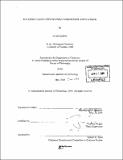Poly(phenylene ethynylene)s in biosensor applications
Author(s)
Zheng, Juan, 1978 June 22-
DownloadFull printable version (25.30Mb)
Alternative title
PPEs in biosensor applications
Other Contributors
Massachusetts Institute of Technology. Dept. of Chemistry.
Advisor
Timothy Swager.
Terms of use
Metadata
Show full item recordAbstract
Conjugated polymers have shown remarkable sensitivity for the detection of a variety of analytes, ranging from explosives to biological molecules such as DNA. This thesis presents three new applications of poly(phenylene ethynylene)s (PPEs) in biosensing applications. Biotinylated PPEs were synthesized for the detection of dye-labeled streptavidin using energy transfer, in the aqueous phase and in the solid phase. These polymers served as a model for multivalent biosensing. Energy transfer was enhanced for dyes which have better orbital overlap with the polymer, indicating an electron exchange energy transfer contribution to the overall signal. In collaboration with Prof. Peter Seeberger's group, mannose-substituted PPEs were synthesized. These polymers used the multivalent presentation of the sugar moieties for the agglutination of Escherichia coli, and offer a rapid method for their detection. The formation of brightly fluorescent bacterial clusters was extended to energy transfer schemes. Amphiphilic biotinylated PPEs were synthesized and used to probe interactions at the air-water interface. Subtle changes in the polymer structure could lead to great differences in protein-ligand interactions. The Langmuir technique offers a sensitive method for understanding the fundamental properties of PPEs.
Description
Thesis (Ph. D.)--Massachusetts Institute of Technology, Dept. of Chemistry, 2005. Vita. Includes bibliographical references.
Date issued
2005Department
Massachusetts Institute of Technology. Department of ChemistryPublisher
Massachusetts Institute of Technology
Keywords
Chemistry.